Grab a cast iron pan and a delicious ribeye steak, because we're going to walk you through How to Cook a Ribeye Steak in a Cast Iron Skillet! Sometimes there's nothing like a good steak with a nice crust and a perfectly cooked interior. We'll show you how to cook your ribeye steak perfectly every time, with just a few minutes with super simple ingredients.

Ribeye steak is the best steak in our opinion, with its delicious fatty marbling. It has so much flavor!
Ribeye steak is the perfect cut in our creamy parmesan steak and seafood skillet, on this steak salad, for this steak appetizer on sweet potato rounds with bacon, or with this steak and lobster! Don't be intimidated by cooking steak at home - it's much easier than you think!
You may also like our air fryer ribeye steak recipe, this bavette steak, these air fryer short ribs, or these air fryer steak tips!
Jump to:
❤️Why we love this recipe
- Quick and easy preparation. Don't be intimidated by making the perfect ribeye steak at home - it's truly simple to master! There's no need for complex marinades, hours of prep time, or fancy equipment. Season the steak, warm up the skillet, and cook the steak to perfection. Dinner can be on the table in minutes. It's a quick and satisfying dinner for busy weeknights or lazy weekends.
- Amazing texture and flavor. Cooking the steak in a hot cast iron skillet ensures a beautiful, caramelized crust on the outside while keeping the inside tender and juicy.
- Versatile for many occasions. Whether you're cooking for a special occasion like date night or just craving a delicious steak dinner, this recipe always works well. It's versatile enough to be enjoyed on its own or paired with your favorite sides like roasted vegetables, mashed potatoes, or a crisp salad.
- Restaurant-quality at home. Impress your friends and family with restaurant-quality steak made right at home!
🥩Ingredients
Here are the ingredients we used for this recipe. You can find more information for substitutions below.
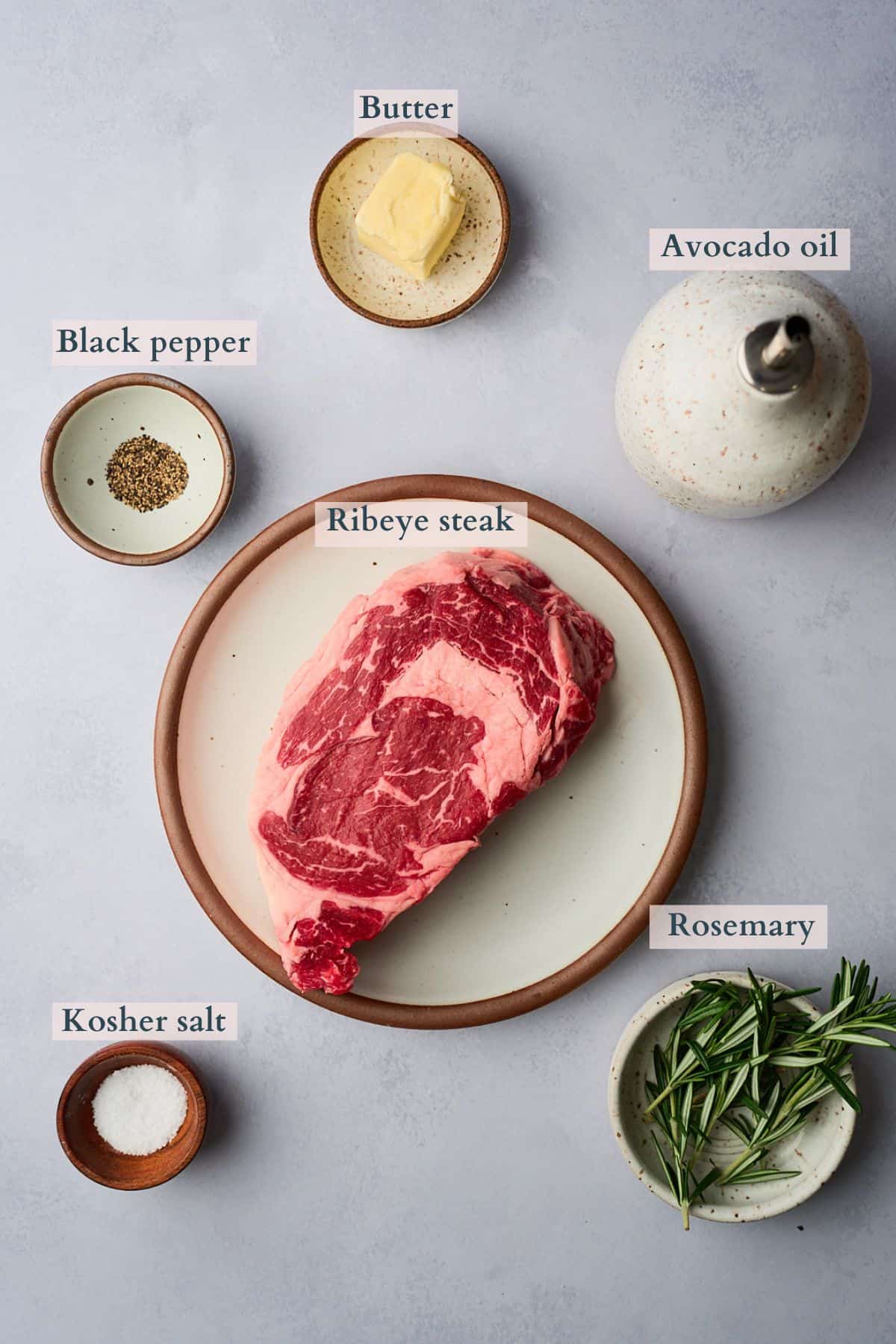
- Ribeye steak. Make sure it's completely thawed. Boneless or bone-in - it's up to you. We tend to opt for a high-quality, grass fed steak whenever possible because we enjoy eating our steak medium-rare. Keep in mind if you plan to enjoy a medium-rare steak as well, and opt for the highest quality you can afford.
- Oil. We like using avocado oil because it has a high smoke point. Olive oil can also be used. We use oil when searing the steak, and then add butter later. If you use butter at this stage, you will just burn it, so definitely start with oil to get a nice crust on the outside of the steak.
- Fresh herbs. We like using fresh rosemary or thyme to baste with butter near the end of cooking. It's totally optional, but it does add a lovely depth of flavor to the meat.
- Butter. Salted or unsalted works here. It is technically optional, but basting hot butter over the top of the steak is a great way to add flavor and get an extra crispy crust on the steak.
Visit the recipe card for the full quantities and nutritional information.
✨Substitutions & Variations
Here are a few suggestions on additional flavors to try, or simple variations to this recipe.
- Add garlic. When you're basting the steak with the herb butter, try adding a few crushed cloves of garlic.
- Extra black pepper. Love extra pepper? Feel free to add more black pepper or freshly cracked black pepper.
- Hint of heat. Love a little bit of heat to your dishes? Try adding some cayenne pepper or red pepper flakes when seasoning the steaks.
🔪Prep work
- Take your steak out of the fridge and let it sit at room temperature for about 30 minutes. This helps it cook more evenly.
- Wash and dry rosemary (if using).
- Measure out seasonings, oil, and butter.
- Preheat a large cast iron skillet over medium-high heat.
📋Instructions
Dry off the steak really well with a paper towel. (Image 1)
Season both sides of the steak generously with kosher salt and coarse ground black pepper. (Image 2)
Be sure that the sides are well coated with salt and pepper as well. (Image 3) Set aside.
Note: The steak can be stored uncovered, in the fridge for up to 48 hours before cooking to dry age it, which ensures lots of extra flavor in the meat.



⭑Pro Tip: Adjust the amount of salt according to the size of your steak, aiming for about 1 teaspoon of kosher salt per pound of meat. You do want to be sure to season generously!
Add oil to the skillet. Carefully place the seasoned steak in the hot skillet. (Image 4)
Don't move it for about 2-3 minutes to develop a nice crust on one side. If you look at the side of the steak, and when you see that the steak is beginning to brown one-third - halfway up the side of the steak, it's ready to flip! (Image 5)
The steak should have a nice crust on one side now. (Image 6)
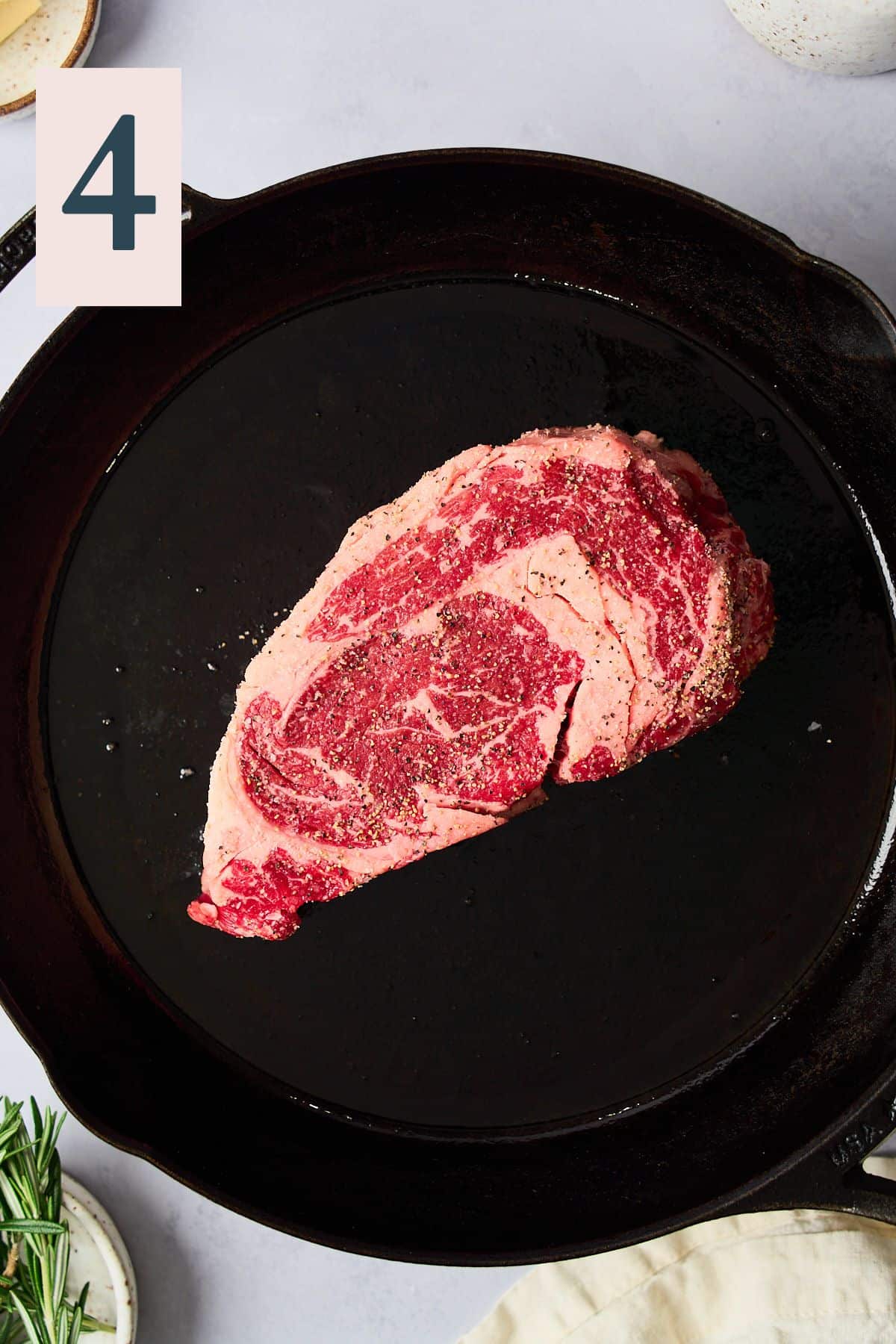


⭑Pro Tip: The steak will naturally release itself when a nice crust has formed. If the steak is sticking to the pan, it's not ready to flip!
Once you have a nice sear on the second side, use your tongs to flip the steak up on its side (where the fat cap is). Hold it upright in the pan for about a minute or two, moving it every 30 seconds or so to ensure all sides are hit. (Image 7)
Once you have cooked the sides of the steak, return it flat in the pan, and cook until the steak is about 10-15°F away from your desired temperature. (Image 8)
Note: In the image below, our thermometer reads 115.7°F. We are aiming for a final temperature between 125°F - 130°F for medium-rare, so this is right on target for this stage. We will continue to cook it when we baste it with butter. (See the temperature guide for more guidance.)
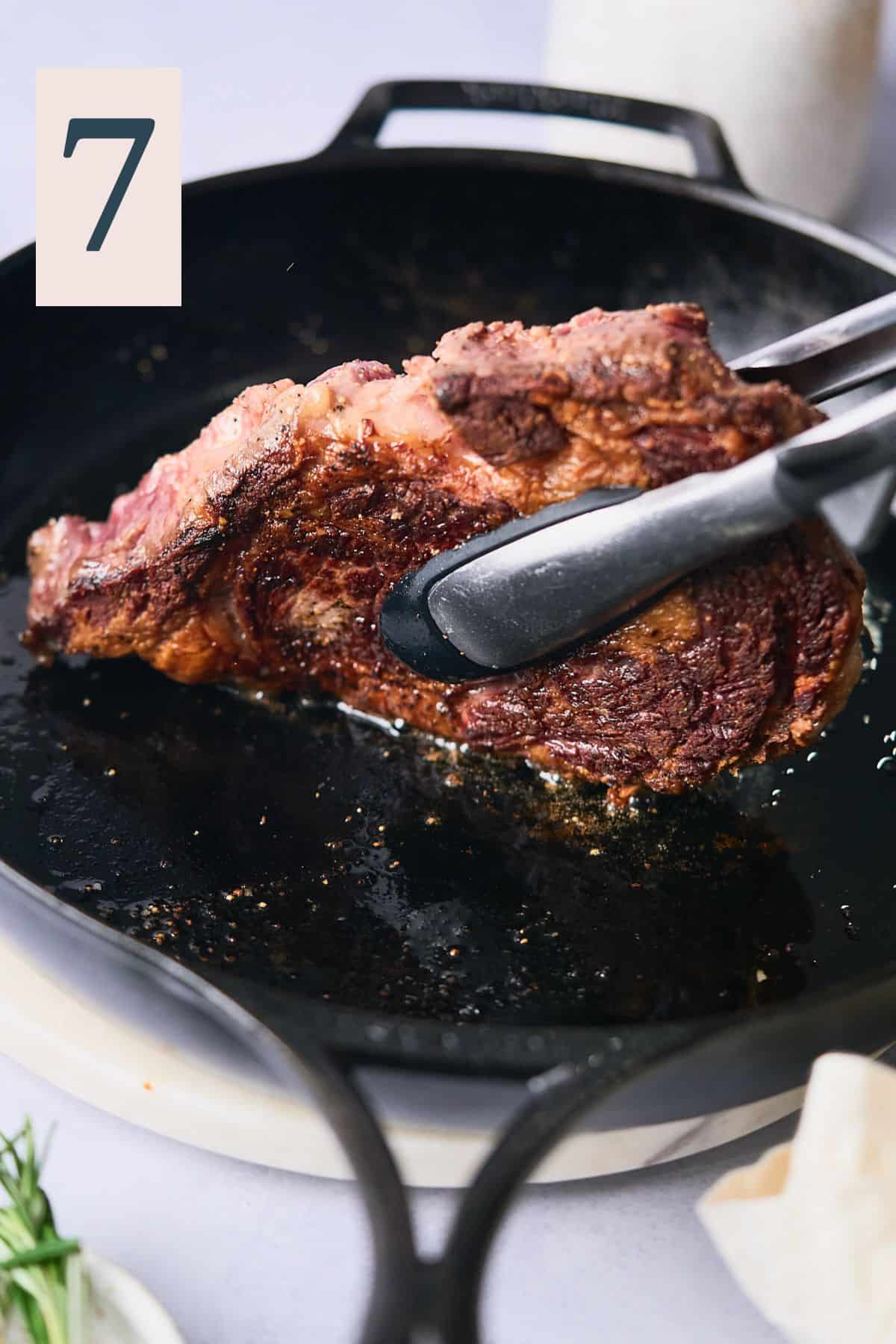
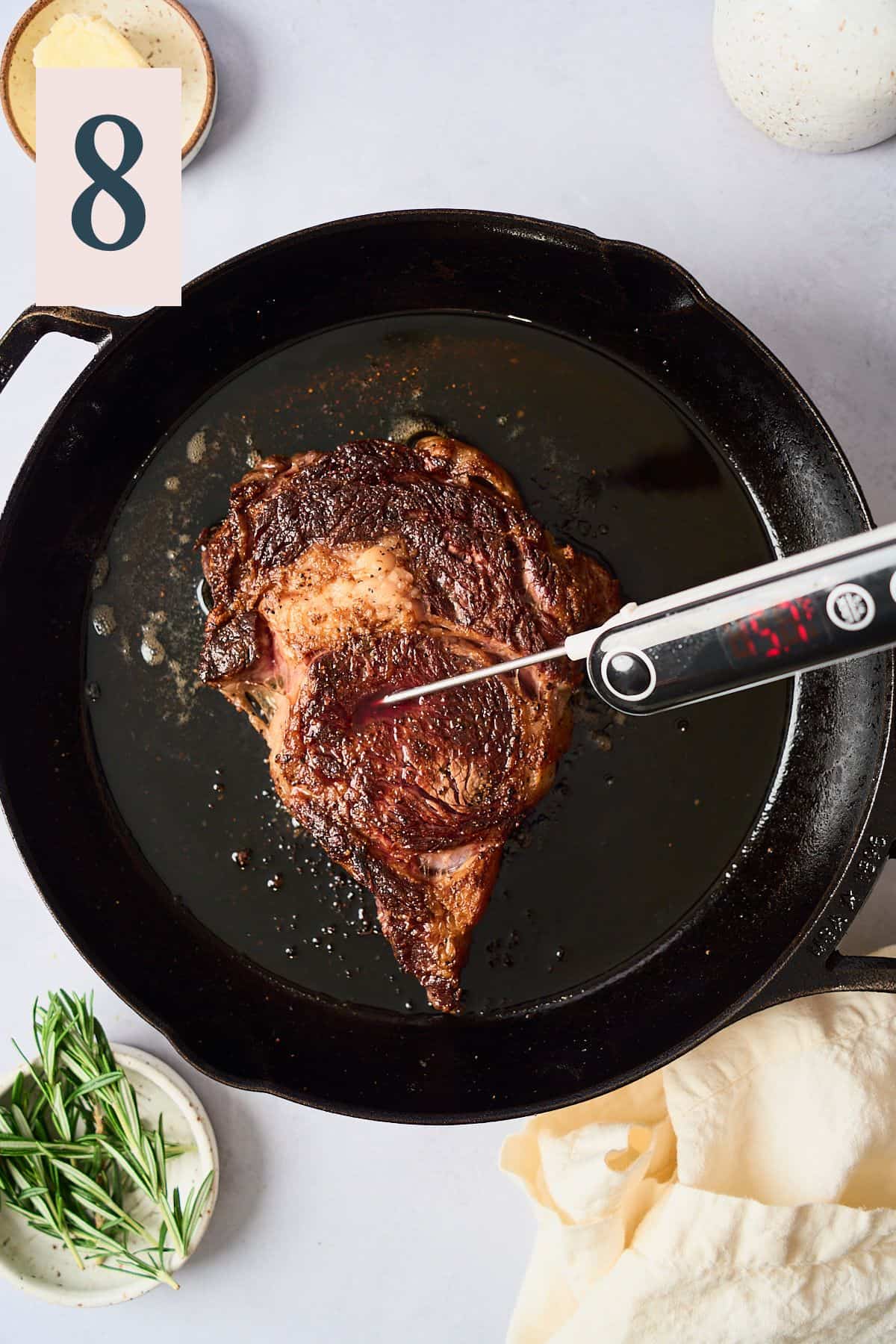
⭑Pro Tip: The cooking time will depend on the thickness of the steak. A digital thermometer is the best way to ensure you don't overcook it. For best results, always use an instant read meat thermometer!
If desired, add the butter and the rosemary sprigs to the skillet. (Image 9)
Tilt the skillet slightly and use a spoon to baste the steak with the melted butter and aromatics for added flavor. (Image 10)
Continue cooking until you're 5°F away from your desired target temperature when you insert a digital thermometer into the thickest part of the steak, then remove it from the pan and let it rest! (See the temperature guide for more guidance.)
Optional step. If skipping the step of basting the steak with butter, continue cooking the steak until about 5°F below your desired temperature!

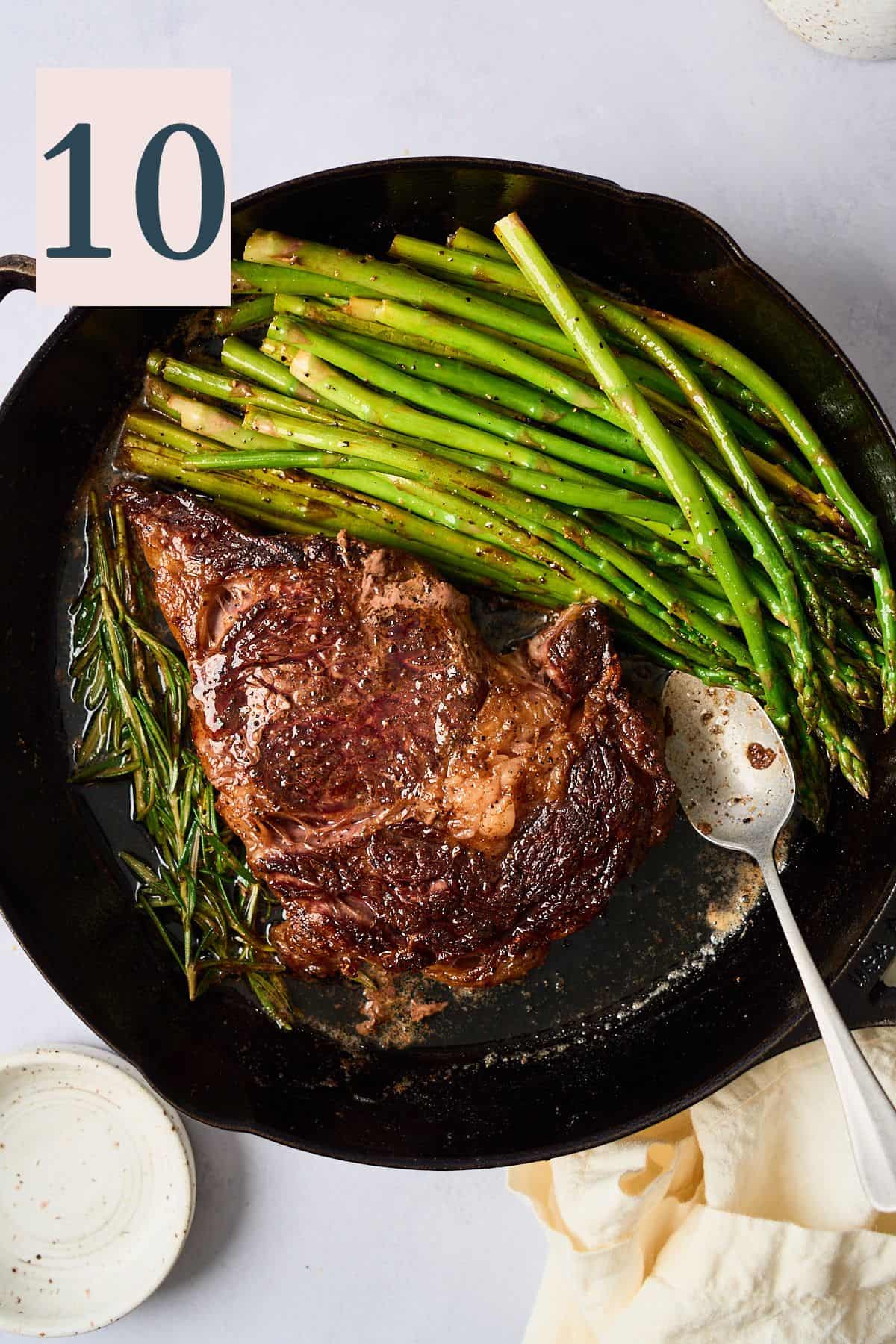
Allow the steak to rest for about 5-10 minutes to allow the juices to redistribute before cutting into it.

⭑Pro Tip: Cut the steak against the grain for tender, juicy bites.
We love topping this cast iron ribeye steak with roasted garlic butter (pictured), dipping it into our fan-favorite cowboy butter dipping sauce, or serving it alongside this creamy horseradish sauce.
Serve and enjoy!
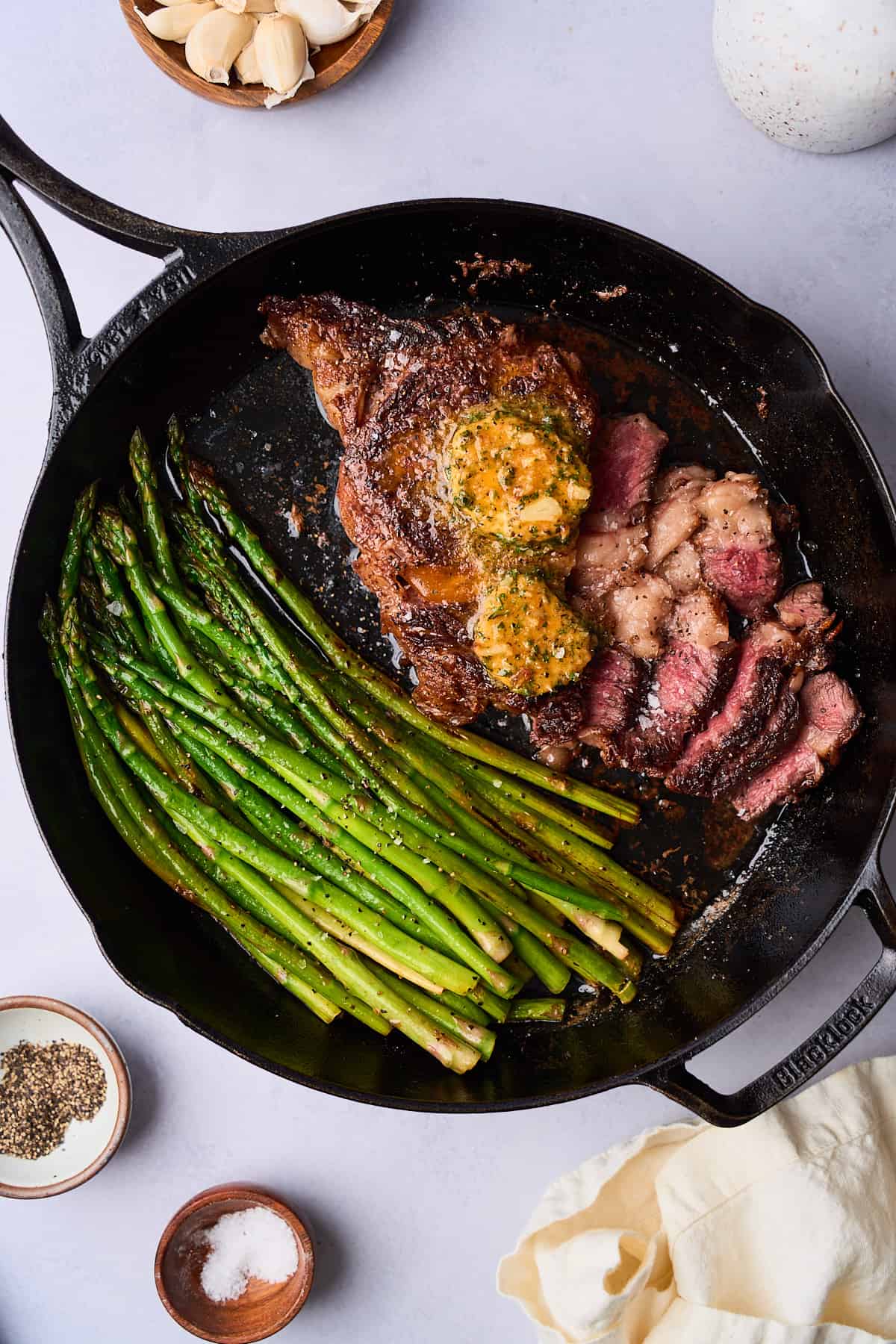
✨Tips & tricks
- Use a meat thermometer! Steak is easy to cook, as long as you don't overcook it. Using a meat thermometer helps you make sure you get it right every time!
- Choose quality meat. Start with a high-quality ribeye steak with good marbling for the best results. High-quality meat will have the best flavor and tenderness. This is really important if you plan to eat the steak medium-rare.
- Room temperature steak. Allow the steak to come to room temperature before cooking. This helps ensure a more even cook.
- Dry the steak. Pat the steak dry with paper towels before seasoning. This helps achieve a better sear and good crust on the steak. Excess moisture will create more of a "steaming" effect - so we want to make sure to get the steak nice and dry.
- Generously season the steak. Don't be shy with the seasoning. Season both sides of the steak liberally with kosher salt and coarse ground black pepper, especially if you have a thick-cut steak!
- Hot skillet. Make sure your cast iron skillet is smoking hot before adding the steak. This ensures a nice sear and locks in the juices. Continue to maintain a medium high heat while the steak cooks.
- Use an oil with a high smoke point. We prefer using avocado oil because it has a very high smoke point of up to 500°F. You can use olive oil, but we truly think avocado oil is the best here.
- Avoid overcrowding the pan. Make sure your skillet is large enough for the steak or steaks you are cooking. You want to give the steak plenty of room, or else you will just
- Use tongs to flip. Use tongs instead of a fork to flip the steak. Piercing the meat with a fork can cause the juices to escape, which can create extra moisture in the pan, as well as make the steak drier.
- Don't skip the butter and herbs. This adds such a great added layer of flavor and richness to the steak.
- Take the steak off the heat a few degrees before the desired temperature is reached. The residual heat will continue cooking the steak, and this ensures that the steak doesn't get overcooked.
- Rest before slicing the steak. Allow the steak to rest for about 5 minutes after cooking it before cutting in. This allows the juices to be redistributed and makes for a more flavorful and juicy steak.
Need supplies? Shop our Amazon store! Stock your pantry, and find all of our favorite kitchen tools! A Full Living LLC earns a small commission through purchases on our storefront to help support this site.
🌡Temperature Guide
Please note, we can't guarantee cook times to achieve the following temperatures. It may take less time with a thinner steak, or more time with a thicker steak, which is why we suggest using a thermometer. Here are some different doneness levels for steak at different temperatures.
- Rare - 120°F - The center of the steak will be cool to warm, very tender, and a red to pink color.
- Medium rare - 130°F - This is generally considered the "perfect cook" on most steaks. It's a pretty popular temperature to order! The center will be read and warm.
- Medium - 140°F - This cook will have a hot pink center, and the steak will be slightly firmer in texture.
- Medium-well - 150°F - This steak will be mostly brown and firm in the center.
- Well done - 160°F+ - Finally, this cook on the steak will have absolutely no pink color in the center. It will be completely brown, firm, and very dry.
🍴What To Serve With Steak
Steak is a great start to any dinner! Here are a few ideas for sides to make it a whole meal!
- Vegetables. Try serving steak with broccoli, some caramelized onions and mushrooms, this air fryer zucchini, these lemon garlic green beans, or this cold asparagus salad. You may also enjoy this crispy pesto cauliflower. A great side salad is also a perfect option, like this arugula and spinach salad!
- Creamy, cheesy sides. This cheesy cauliflower bake, this steakhouse creamed spinach, and this Southern baked mac and cheese are all excellent choices to accompany steak!
- Potatoes. Steak and potatoes are a perfect match. Try serving it with these truffle mashed potatoes for a little flair, or over a bed of these redskin mashed potatoes. You may also enjoy these gluten free scalloped potatoes! These air fryer fingerling potatoes and these smashed potatoes with garlic, cheese, and herbs are perfect! You may also enjoy these creamy mashed turnips if you're looking to lower the carbs.
- Bread. You can't go wrong with a quick side of air fryer garlic bread, these honey cornbread muffins, or even this sweet potato cornbread!
💭Frequently Asked Questions
Store leftovers in an airtight container in the fridge for up to 5 days. We don't recommend freezing.
To reheat the ribeye, carefully heat it in a pan with a little extra oil or butter. Keep in mind that the steak will cook further every time you reheat it.
Using the microwave, or a lower heat (350°F) in the air fryer, or in the oven are also options. If using the microwave, set it to 50% power to avoid cooking it too fast.
A good indicator that the skillet is hot enough is when it starts to smoke slightly. You can also test by sprinkling a few drops of water onto the skillet – if they sizzle and evaporate immediately, it's ready.
While a cast iron skillet is preferred for its ability to retain heat and create a good sear, you can use a stainless steel pan as well.
Check out our guide on how to care for and clean a cast iron skillet for full instructions, tips, tricks, and FAQs!
More Recipes To Consider
Did you try this recipe? Make sure to leave a 5-star review below! 🌟 This helps other readers find our recipes and encourages them to try them. Also, be sure to leave a comment with your experience. Follow along, and tag @AFullLiving on Instagram with your photos!
📖 Recipe

Cast Iron Ribeye Steak
Ingredients
- 1.5 teaspoons kosher salt (Depends on the size of your steak, we used 1.5 teaspoons because our steak was 1.5 pounds. We recommend about 1 teaspoon of kosher salt per pound of meat - to taste!)
- ½ teaspoon course ground black pepper (to taste)
- 1.5 pounds ribeye steak boneless
- 1 tablespoon avocado oil can sub olive oil or a high heat cooking oil
- 1 tablespoon butter (optional)
- 3 springs rosemary (optional)
Instructions
- Take your steak out of the fridge and let it sit at room temperature for about 30 minutes. Dry it off with a paper towel. Preheat a large cast iron skillet over medium-high heat.
- Season both sides of the steak generously with kosher salt and coarse ground black pepper. Be sure that the sides are well coated with salt and pepper as well. Set aside. (You want to use about 1 teaspoon of kosher salt per pound of meat.)Note: The steak can be stored uncovered, in the fridge for up to 48 hours before cooking to dry age it, which ensures lots of extra flavor in the meat.
- Add 1 tablespoon of avocado oil to the hot skillet. Carefully place the seasoned steak in the hot skillet. Don't move it for about 2-3 minutes to develop a nice crust on one side. If you look at the side of the steak, and when you see that the steak is beginning to brown one-third - halfway up the side of the steak, it's ready to flip, one side of the steak should have a nice crust.
- Once you have a nice sear on the second side, use your tongs to flip the steak up on its side (where the fat cap is). Hold it upright in the pan for about a minute or two, moving it every 30 seconds or so to ensure all sides are hit. Once you have cooked the sides of the steak, return it flat in the pan, and cook until the steak is about 10-15°F away from your desired temperature. (We were aiming for a medium-rare which is between 125°F-130°F, so for us we began basting the steak with butter at 115°F.
- If desired, add 1 tablespoon of butter and the rosemary sprigs to the skillet. Tilt the skillet slightly and use a spoon to baste the steak with the melted butter and aromatics for added flavor. Continue cooking until you're 5°F away from your desired target temperature when you insert a digital thermometer into the thickest part of the steak, then remove it from the pan and let it rest!
- Allow the steak to rest for about 5-10 minutes to allow the juices to redistribute before cutting into it.
- Top with your favorite buttery dipping sauce and serve with your favorite sides. Enjoy!
- Store leftovers in an airtight container in the fridge for up to 5 days. We don't recommend freezing. To reheat the ribeye, carefully heat it in a pan with a little extra oil or butter. Keep in mind that the steak will cook further every time you reheat it. Using the microwave, or a lower heat (350°F) in the air fryer, or in the oven are also options. If using the microwave, set it to 50% power to avoid cooking it too fast.
Notes
- Use a meat thermometer! Steak is easy to cook, as long as you don't overcook it. Using a meat thermometer helps you make sure you get it right every time!
- Choose quality meat. Start with a high-quality ribeye steak with good marbling for the best results. High-quality meat will have the best flavor and tenderness. This is really important if you plan to eat the steak medium-rare.
- Room temperature steak. Allow the steak to come to room temperature before cooking. This helps ensure a more even cook.
- Dry the steak. Pat the steak dry with paper towels before seasoning. This helps achieve a better sear and good crust on the steak. Excess moisture will create more of a "steaming" effect - so we want to make sure to get the steak nice and dry.
- Generously season the steak. Don't be shy with the seasoning. Season both sides of the steak liberally with kosher salt and coarse ground black pepper, especially if you have a thick-cut steak!
- Hot skillet. Make sure your cast iron skillet is smoking hot before adding the steak. This ensures a nice sear and locks in the juices. Continue to maintain a medium high heat while the steak cooks.
- Use an oil with a high smoke point. We prefer using avocado oil because it has a very high smoke point of up to 500°F. You can use olive oil, but we truly think avocado oil is the best here.
- Avoid overcrowding the pan. Make sure your skillet is large enough for the steak or steaks you are cooking. You want to give the steak plenty of room, or else you will just
- Use tongs to flip. Use tongs instead of a fork to flip the steak. Piercing the meat with a fork can cause the juices to escape, which can create extra moisture in the pan, as well as make the steak drier.
- Don't skip the butter and herbs. This adds such a great added layer of flavor and richness to the steak.
- Take the steak off the heat a few degrees before the desired temperature is reached. The residual heat will continue cooking the steak, and this ensures that the steak doesn't get overcooked.
- Rest before slicing the steak. Allow the steak to rest for about 5 minutes after cooking it before cutting in. This allows the juices to be redistributed and makes for a more flavorful and juicy steak.



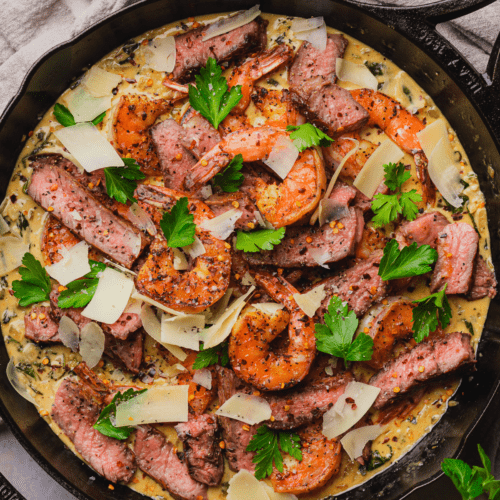

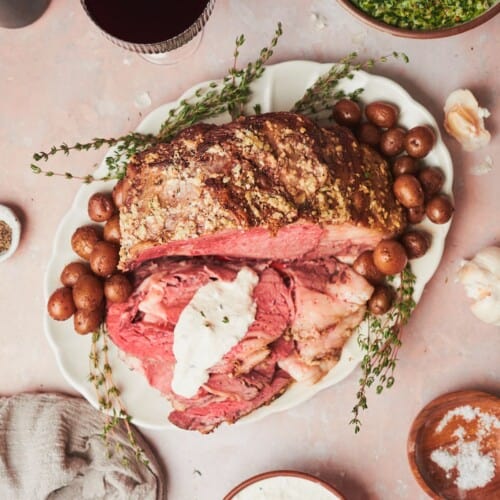
Comments
No Comments